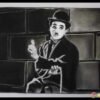Short Info & History
Impasto painting is a distinctive technique characterized by the application of paint in thick layers, resulting in a textured surface where brush or palette knife marks are clearly visible. This method adds a three-dimensional quality to the artwork, engaging viewers through its tactile and visual appeal. The term "impasto" is derived from the Italian word for "dough" or "paste," reflecting the thick, malleable nature of the paint used in this technique.
Historically, impasto techniques date back to the Renaissance, though they gained prominence during the Baroque period. Artists like Rembrandt used impasto to create dramatic contrasts of light and shadow. The technique saw further evolution in the 19th and 20th centuries with artists such as Vincent van Gogh and Jackson Pollock, who used it to express emotion and dynamism in their works.
Impact on Society
Impasto painting has had a profound impact on society and the art world. By emphasizing texture and depth, it challenges traditional notions of painting as a purely visual medium, encouraging viewers to appreciate the tactile qualities of art. This technique has inspired various art movements and practices, contributing to the development of modern and contemporary art.
Moreover, impasto painting has influenced other forms of creative expression, such as sculpture and mixed media, by highlighting the importance of texture and physicality. It has also played a role in art therapy, where the act of applying thick layers of paint can be therapeutic and expressive for individuals.
Artists Influenced by Impasto
Several notable artists have been influenced by or have mastered the impasto technique:
- Rembrandt: Known for his masterful use of chiaroscuro (light and shadow), Rembrandt utilized impasto to add texture and depth to his portraits, enhancing their realism and emotional impact.
- Vincent van Gogh: Van Gogh's expressive brushstrokes and vibrant colors are iconic examples of impasto painting. His works, such as "Starry Night" and "Sunflowers," showcase the technique's ability to convey movement and emotion.
- Jackson Pollock: As a leading figure of Abstract Expressionism, Pollock's impasto techniques added energy and movement to his action paintings. His innovative use of thick paint and unconventional tools revolutionized modern art.
Composition
Impasto painting requires careful consideration of composition to balance the visual weight of the thick paint. Artists often plan their compositions meticulously, thinking about how the texture will interact with light and shadow to create depth and interest. The composition must also account for the physical properties of the paint, ensuring that the layers are stable and cohesive.
In addition to traditional composition principles, impasto artists may experiment with abstract forms, dynamic brushwork, and varied textures to create visually striking pieces. The tactile quality of impasto adds an additional layer of complexity to the composition process, as artists must think about both the visual and physical aspects of their work.
Specific Properties
Impasto painting has several specific properties that set it apart from other techniques:
- Thickness: The defining characteristic of impasto is its thick application, creating a raised, textured surface that stands out from the canvas.
- Light Interaction: The texture of impasto paintings interacts with light in unique ways, casting shadows and highlighting the paint's contours. This adds depth and dimension to the artwork, making it more dynamic and engaging.
- Durability: The thickness of the paint can make impasto paintings more durable, as the layers provide added protection against wear and tear. However, this also means that the paintings may be more susceptible to cracking or other forms of damage if not properly cared for.
Key Features
Key features of impasto painting include:
- Visible Brushstrokes: The technique leaves prominent brush or palette knife strokes, adding a personal touch to the artwork and showcasing the artist's hand in the creation process.
- Three-Dimensional Quality: The thick paint creates a sense of depth and dimension, making the artwork more engaging and allowing viewers to appreciate the physicality of the paint.
- Expressiveness: The texture and thickness of the paint allow artists to convey emotions and sensations through their work, making impasto painting a highly expressive and dynamic technique.
Surface or Media
Impasto can be applied to various surfaces, each offering different effects and challenges:
- Canvas: A popular choice for impasto painting, canvas provides a sturdy and flexible surface that can support the weight of the thick paint.
- Wood Panels: Wood panels offer a rigid and durable surface, allowing for greater control and stability when applying thick layers of paint.
- Paper: While less common, paper can also be used for impasto painting, though it may require additional preparation and reinforcement to handle the weight of the paint.
The choice of surface can affect the final appearance and durability of the artwork, so artists must carefully consider their options based on their desired outcome and working methods.
Materials Used
Impasto painting typically involves the use of specific materials:
- Oil Paints: Traditionally used due to their thick consistency and slow drying time, oil paints are ideal for impasto techniques. They allow artists to build up layers of paint and achieve the desired texture.
- Acrylics: Acrylic paints can also be adapted for impasto techniques, offering quicker drying times and greater flexibility. They can be thickened with various mediums to achieve the desired consistency.
- Palette Knives and Brushes: Essential tools for applying the thick layers of paint, palette knives and brushes come in various shapes and sizes to create different textures and effects. Artists may also use unconventional tools, such as spatulas or even their hands, to apply the paint.
Other Specialties
Impasto painting can be combined with other techniques and materials to create unique and innovative artworks:
- Mixed Media: Impasto can be combined with collage, sculpture, or other mixed media techniques to add depth and complexity to the piece. Artists may incorporate various materials, such as fabric, paper, or found objects, to enhance the texture and visual interest.
- Layering: Artists often layer the paint to build up the desired texture, adding depth and complexity to the piece. This can involve applying multiple layers of paint, each with different colors and textures, to create a rich and dynamic surface.
Vegan-Friendly and Toxicity
Modern impasto materials can be made vegan-friendly, with manufacturers offering cruelty-free and non-toxic paint options. Some vegan-friendly art supplies include:
- Vegan Acrylic Paints: Brands like Golden Acrylics offer vegan options, except for paints that include bone black pigment. These paints are made without animal-derived ingredients and are considered safe for use.
- Vegan Brushes: Synthetic brushes are available as alternatives to natural hair brushes, providing a cruelty-free option for artists.
Regarding toxicity, it's essential to be aware of the potential hazards of certain art materials:
- Cadmium Paints: Cadmium-based paints are known to be toxic and linked to health risks such as cancer and respiratory problems. Artists should use these paints with caution and follow proper safety guidelines.
- Non-Toxic Alternatives: Many companies now offer non-toxic alternatives that are safe for use, such as cadmium-free acrylic paints. These paints provide the same vibrant colors and texture without the associated health risks.
Conclusion
Impasto painting continues to push the boundaries of traditional two-dimensional art, offering a tactile, engaging experience that captivates both artists and audiences. Whether you're an artist looking to experiment with new techniques or an art enthusiast eager to explore different styles, impasto painting offers a rich and rewarding journey into the world of textured art.










Leave a Reply